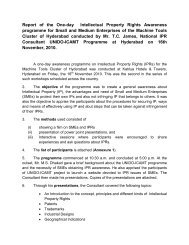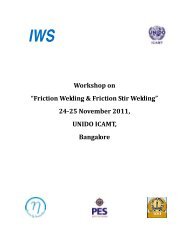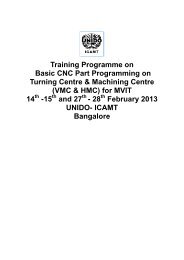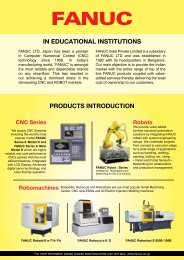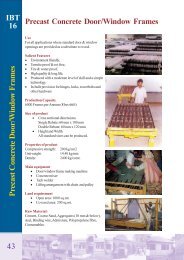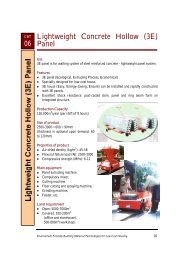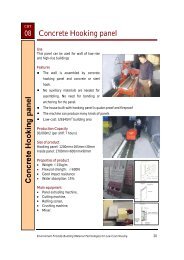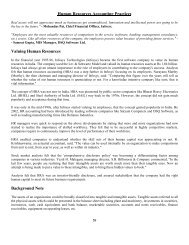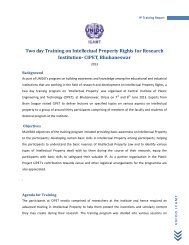Download File Course Material Energy Audit - UNIDO-ICAMT
Download File Course Material Energy Audit - UNIDO-ICAMT
Download File Course Material Energy Audit - UNIDO-ICAMT
- No tags were found...
Create successful ePaper yourself
Turn your PDF publications into a flip-book with our unique Google optimized e-Paper software.
20-11-2012WHY SAVE ENERGY ?Prospects of <strong>Energy</strong> Savings in the PlasticIndustry‣ With the rapid and sharp rise in energyprices energy cost is becoming a value thatcannot be ignored in the Plastic Industry.‣However, there are still many practicesadopted in industry that do not take energyefficiency as a prime consideration, but ratherfocus on immediate and direct savings inmaterials and machinery.Potential opportunities of <strong>Energy</strong>savings in other industrial sectors It is demonstrated by conducting <strong>Energy</strong><strong>Audit</strong> that <strong>Energy</strong> saving is a superior optionto increase profit and competition. To achieve this purpose, several detailedenergy audits have been carried out4
20-11-2012Our Observations and recommendations givenin terms of electrical energy savings based on our<strong>Energy</strong> <strong>Audit</strong> Studies:A substantial annual percentage saving of 10 to40 % have been identified•If it is possible in other industries why not inPlastics when plastic facilities use high rates ofelectrical energy consumption to maintain theirproductionsPrimary energy end uses common inPlastic Industry irrespective of the kind ofProducts1. Electrical Heaters,2. Air compressors,3. Electrical Motors,4. Water Pumps5. Electric lightings,6. HVAC,7. Boilers,8. Chillers5
20-11-2012Factors considered while <strong>Energy</strong><strong>Audit</strong>ing‣ Electrical energy savings (kWh)‣ Electrical demand savings (kW)‣ Electrical energy cost savings (JD)‣ Payback period (within 3 years only)‣ Quantification of cost savings‣ FinalRecommendations<strong>Energy</strong> Conservation Opportunities Improvement of the Electrical Power Factor Installation of Variable Frequency Drives(VFD): Replacement of energy inefficient motors andrewound motors with efficient ones Plugging Compressed Air Leaks6
20-11-2012MANUFACTURING METHODS OFPLASTICS• Extrusion• Injection molding• Blow molding• Thermoforming• Rotational molding• Casting• Foaming• Compression molding• Transfer molding• Welding, Finishing, assembly & post processIRRESPECTIVE OF MANUFACTURINGPROCESSES ENERGY CONSUMPIONDEPENDS ON:• PRESSURE APPLIED• OPERATINGTEMPERATURE• MATERIAL FLOW RATE7
20-11-2012• Motors,BIGGEST ENERGY CONSUMERS• Heating units,• Cooling processes,• Compressors.• It is advisable to look at energy consumption in relation to time.• It can then be seen if energy consumption is commensuratewith production.• The large energy consumers in particular must carefully matchto the process to ensure they do not operate unnecessarily8
20-11-2012InjectionMouldingCompressionMouldingPurchase price vis a vis Life time ownership costIf one looks at the purchase price and consumption of a mouldingmachine, the purchase price of a moulding machine is lower thanthe energy costs of operating the machine over its working life.<strong>Energy</strong>-saving machines will save money in the long term.It is therefore not the purchase price that should be the top prioritywhen purchasing a new machine, but rather the consumptionor ‘total cost of ownership’..9
20-11-20128510machinescompressor1760HVAClightingcooling<strong>Energy</strong> percentage in Plastic making<strong>Energy</strong> consumption is attributable tothe following actions: (specific to theprocessing technique)• Melting of raw materials• Cooling (mould, gauges, oil, etc.)• Peripheral equipment such as grinders, compressors, pumps, pre-driers,mixers, etc.• Vacuum formation of semi-manufactured products• Machinery, hopper fillers, dosing systems,• conveyor belts• Space heating, cooling,• Lighting.10
20-11-2012Extrusion Processing <strong>Energy</strong> Saving Measures:• Choose the right extruder. A poor choice of screw/mould combination results in higherenergy consumption.• Optimize the speed of the extruder.• Switch off as many energy consumers as possible when there is no production.• This is mainly the extruder’s heating and cooling. Stand-by power consumption is thuslimited.• Make sure the housing of the extruder is well insulated.• Keep the melting temperature of the plastic pellets as low as possible.• Try to minimize the use of compressed air. Use fans for cooling instead of compressedair.• Thermal heating is often mostly electrical. Compare this with using gas.• Use free cooling. Free cooling can be used when the outside temperature is lower thanthe cooling water that goes back to the chiller. This cools the water before it goes to thechiller. The lower the outside temperature, the greater the effect of free cooling. Thismeans the compressors use less energy for cooling.Injection molding <strong>Energy</strong> Conservation measures:• Make sure the parameters for the object being produced are optimal• Is the process stable?• Is the mould periodically cleaned?• Optimize the cycle time. Determine if the cycle time can be reduced.• Is the current installation still suitable for the product beingmanufactured?• Are procedures in place for switching off energy consumingequipments during longer duration production stops?11
20-11-2012BLOW MOULDING - <strong>Energy</strong> SavingmeasuresMinimize Cycle TimeEnsure perfect InsulationOptimize cooling systemOptimize Air compressor operationSpecific consumption of plastics processingThe measure of energy consumed for every unit productionThe specific energy consumption is calculated bydividing the annual energy consumed in KWHby the annual production in Tonnes or KGSpecific <strong>Energy</strong> consumption : Annual KWH consumedAnnual production in Tonnes or KGThere is no major difference between injection and extrusion moulding.The average consumption per kWh/kg barely differs.12
20-11-2012<strong>Energy</strong> consumption FactorsSpecific energy consumption KWH/KG differ from plant to plantType and characteristics of the plastic(for instance, each material has a different melting temperature)Design, complexity, and size of the end product.The greater the pressure on the mould, the more energy is consumedEach technique used for the shaping of the product has its own specific energyconsumption, (KWH/KG) depending on heating, moulding, and coolingThe higher the quantity of production, the lower the specific energy consumptionThe cycle time determines how long the pump or electrical motor is switched onduring the moulding processSize of the plantFrequency of use of the mouldOutside temperature (there is a 10 per cent higher consumption in the summerSpecific energy consumption (KWH/KG) ofdifferent processes• Blow Moulding - 1.5 to 2.20•Injection Moulding -•Extrusion moulding -1 to 2.2 KWH/Kg0.5 to 1.8 KWH/Kg13
20-11-20122005 Bench Marking of <strong>Energy</strong> consumption for European plasticIndustry• The average site specific energy consumption was 2.87KW/Kg/Hour• The energy consumption ranges from 0.63 KW/Kg/Hour forcompounding to 6.2 KW/Kg/Hour for vacuum thermoforming• Specific <strong>Energy</strong> consumption was higher for small machines andlower for electric vs hydraulic drives• 40 % used the services of energy consultants• 50 % felt it is their responsibility to honor and follow the KyotoProtocolBench Marking for <strong>Energy</strong> Performance• Bench marking parameters revolve around matchingenergy use to equipment• Quantification of fixed and variable energy consumptiontrends vis- a - vis production rate• Comparison of the energy performance with respect tocapacity utilization• Identification of best industry practices, based onexternal bench marking data• Scope energy and cost reduction• Optimize system efficiency14
20-11-2012<strong>Energy</strong> Conservation Tips• Applicable toHigh <strong>Energy</strong> consuming machinesELECTRIC MOTORSCONVERSION OF ELECTRICAL TO MECHANICAL ENERGYMOTOR TYPES1. AC INDUCTION MOTORS2. AC SYNCHRONUS MOTORS3. DC MOTORS15
20-11-2012MOTOR EFFICIENCY• FOR MOTORS FROM 10 TO 500 HP,MOTOR EFFICIENCY VARIES FROM 85 TO 95 %• EFFICIENCY & POWER FACTOR1. BELOW 50 % LOAD, EFFICIENCY DROPS SIGNIFICANTLY2. Power factor reduces with load, ranging from 0.05 to 0.25 on no-load3. No - load current is 30 to 50 % of the full - load currentLIFE CYCLE COST OF ELECTRIC MOTOR• EVEN A SMALL 7.5 KW MOTOR AT FULL LOAD ELECTICITY WORTH Rs 20LACS IN 10 YEARS (CALCULATED IN 2008) – compare with cost of the motors• A 37 KW MOTOR CONSUMES Rs one Cr in 10 years• A very small change in efficiency can make a significant difference in therunning cost in operation• Motors may be replaced if economically justified irrespective of age• Use <strong>Energy</strong> efficient motor with sophisticate technology which will be costeffective with the least pay back period16
20-11-2012TIPS FOR ENERGY EFFICIENCY INELECTICAL UNTILITIES• Maintain High Load factor Schedule your operations• Shift loads to off-peak time• Minimize maximum demands• Stagger start up times for equipments with large starting currents tominimize local peaking• Use diesel generator for on-peak high load periods• Correct Power factor to minimum 0.95• Relocate transformers close to main loads• Set transformer taps to optimum settings• Disconnect primary power to transformers that do not serve anyactive loads• Shut off unnecessary utilities, computer, printer. copier etcMOTORS• Properly size the motor to the load for optimum efficiency• Use energy efficient motors• Use synchronous motors to improve power factor• Check alignment• Provide proper ventilation (10 degree C temp raise halves the motor life)• Check for under voltage and overvoltage conditions• Balance the three phase power supply (An imbalanced voltage can reduce3 to 4 % of input power)• Demand efficiency restoration after motor rewinding ( rewound motorefficiency loss is around 8%)• If the motor is constantly loaded below 30% connect it to star afterstarting from delta by star-delta- star starter17
20-11-2012DRIVES• USE VSD FOR LARGE VARIABLE LOADS• USE HIGH EFFIENCY GEAR SETS• USE PRECISION ALIGNMENT• CHECK BELT TENSION PROPERLY• USE FLAT BELTS IN PLACE OF V – BELTS• SHUT THEM OFF WHEN NOT NEEDEDENERGY CONSERVATION OPPORTUNITESIN LIGHTING SYSTEM• Reduce excessive illumination levels to standard level• Wherever manual control is in practice employ auto controlsystem like timers, photocells, occupancy sensors etc• Incandescent lighting is highly power intensive and exploreand replace with energy efficient lighting system such as CFL,Sodium Vapor Lamp, Metal Halide, LED• Select ballasts and lamps with high Power Factor and longterm efficiency in mind18
20-11-2012Water pumps• Operate near best efficiency point• Modify capacity to minimize throttling• Introduce variable Speed drives to adapt wideload variation• Arrest all leakages• Repair water seals and packing to minimizewater wastage• Ensure Proper alignmentWater and Waste Water• Recycle water• Arrest water leaks• Check water over flow pipes, water tanks• Fix and monitor water meters for drinkingwater lines19
20-11-2012COMPRESSED AIR• Avoid over sizing – Match the connected load• Reduce the air compressor dischargepressure to the lowest acceptable setting• Use waste heat for a wide range ofapplications• Replace V belts with high efficiency Flat Belts• Consider alternatives to Compressed airDIESEL GENERATING SETThe major energy saving opportunities are:• Ensure high quality maintenance and upkeep of the equipments.• Ensure clean fuel oil and air supply to the engine.• Ensure steady load conditions, avoid fluctuations, imbalance in phases.• Carry out regular field trial to monitor performance/-plannedmaintenance20
20-11-2012R.E.<strong>Energy</strong>Efficiency<strong>Energy</strong> Requirementfurther reduced byincreased efficiency so thatcomplete requirement ismet with Renewable<strong>Energy</strong> sources & devices<strong>Energy</strong> Requirementreduced by adoption ofenergy conservationmeasures<strong>Energy</strong> ConservationBusiness As usual energyrequirements<strong>Energy</strong> Conversion (Pneumatic toelectric drivers, electric heating tosteam heating)<strong>Material</strong> Economy (Recovery of scrap,reduction of waste, salvage or recovery ofreusable parts)<strong>Energy</strong>-efficient lighting, high efficiency boilers,motors, pumps, fans, part load operation, controls,more efficient processesENERGY EFFICIENCYConfine energy, reduce losses, minimise compressed air leaks,HVAC infiltration, correct sizing, smaller capacity for low loads,optimal loading of equipment, value engineeringReview of historical energy use, House keeping (filter cleaning, leakageslubrication, cleaning of light fixtures), Avoid un-necessary operations, misuse& wrong operational methodsENERGY CONSERVATION21
20-11-2012CASE STUDIES IN ENERGYCONSERVATION AND AUDITThe major energy saving opportunities identified in a number ofindustrial and commercial establishments along with costbenefitsand pay back periods are illustrated in thefollowing slidesSTARTECH LABSMadinaguda – HyderabadSourceEquipmentTube lightsIncandescentlampA.C. LoadRecommendationfor<strong>Energy</strong>SavingBy replacingwithelectronicchokesBy replacingincandescent lamp byCFLBy Propertemp.Setting &maintenanceEstimatedAnnual<strong>Energy</strong>Saving(KWH)EstimatedAnnualSaving(Rs.)Estimatedinvestment(Rs.)PaybackPeriod1746 10861 31500 2 year 11month1240 7713 2600 4 month1705 10605 Nil Immediate22
20-11-2012VIGNAN ENGINEERING COLLEGE,VADLAMUDI, GUNTUR (Deemed University)-2008( WITHOUT INVESTMENTS)Sl. NO Type of <strong>Energy</strong> Units in KWH/Liters1 Electrical System 1,33,230.00 KWH2 Transport System: HSD + LUB 16000 + 1000 lITRES3 Total Savings Electrical and HSD+Lub Oil 1,33,230.00 KWH17,000 Liters (HSD+Lub)VIGNAN ENGINEERING COLLEGE,TRANSPORT SYSTEM - WITH INVESTMENTSS No Recommendation Cost ofoverhaulingRs1 Major Overhauling of 4Vehicles6849,2649,3747,6894,(4629 – Engine)2 Corrective Maintenanceof 17 vehiclesFuel savingexpected2,00,000 20 % (20,000lit) and lube1000 lit3,60,000 10% (10000lit) and lube500ltrsTotal 5,60,000.00 30000 HSD1500 LubeSaving perannum RsPay back periodHSD-1,700000 3 monthsLube: 140000Rs. 8,40,00010000 liters3,50,000.00 3monthsLube:70,000.004,20,000.0015,59,100.00 3 months23
20-11-2012VIGNAN ENGINEERING COLLEGE,TRANSPORT SYSTEM - WITH INVESTMENTSS No Recommendation Cost ofoverhaulingRs1 Major Overhauling of 4Vehicles6849,2649,3747,6894,(4629 – Engine)2 Corrective Maintenanceof 17 vehiclesFuel savingexpected2,00,000 20 % (20,000lit) and lube1000 lit3,60,000 10% (10000 lit)and lube500ltrsTotal 5,60,000.00 30000 HSD1500 LubeSaving perannum RsHSD-1, 700000Lube: 140000Rs. 8,40,00010000 liters3,50,000.00Lube:70,000.004,20,000.00Pay backperiod3 months3months15,59,100.00 3monthsVIGNAN ENGINEERING COLLEGE,ABSTRACT-ENERGY SAVING POTENTIALSl.NoType of <strong>Energy</strong> Units in KWH HSD/Lube in Lit Amount ofSavings Rs1 Total savings withoutinvestment1,33,230 KWH 16000 lit HSD1000 lit Lube13,91,442.002 Total Savings with investment 60,756 Kwh 30000 lit HSD1500 lit LubeGross Savings 1,93,986 Kwh 46000 lit HSD2500 lit Lube18,87,183.0032,78,625.00Investment Required 15,06,450.00Net Savings 17,72,175.0024
20-11-2012ENERGY AUDIT OF HEAVY EARTH MOVINGMACHINERY&TWO COAL WASHERIESKATHATA AREA OF O C PS & COAL WASHERIESUNDER CENTRAL COLLIERIES LTDBYPETROLEUM CONSERVATION RESEARCH ASSOCIATIONEASTERN REGION, KOLKATA<strong>Energy</strong> <strong>Audit</strong> conducted by G Harihara Iyer for PCRATHE ENERGY AUDIT OBJECTIVES:• TO ACHIEVE , OPTIMISE FUELEFFICIENCY• OPTIMISE PEFORMANCE EFFICIENCY25
20-11-2012RECOMMENDATIONSOPTIMISING LOADING/HAULING COMBIANATIONS• JARANGDIH-EKG5A CIL No.EXC2376 - 4.5 Cub M Bucket with 3 Nos 35 TDumpers• KATHARA –(i) 182 Marion 10 Cub M shovel with 4 Nos of 85 T dumpers(ii) Tata Hitachi EX 350 LCH-1.9 Cub Meter bucket used for loadinginto 85 Ton Dumpers in Kathara Mines (27 Passes-12 minutes)-Better combination with 35 T Dumpers• SAWANG –EKG - 5 A CIL No: EXC 1724, Bucket capacity: 5 Cub M WITH 4 Nos of35 T Dumpers• Two coal washeries in Kathara and SawangRecommendations based on Time studyUNDERSCORING NEED FOR IMPROVING EFFICENCY BY IMPROVING: WORKING FACE, HAULAGE ROAD DUMP MANGEMENT GRADING HAULAGE ROAD TWICE A SHIFT WITH MOTOR GRADER PROVIDE ROAD WIDTH MINIMUM 25 M ROAD WIDTH - 85 T /20M - 35 T BETTER CAMBER, CONSOLIDATING ROAD SURFACE MINIMUM 20 M TURNING RADIUS ADJUSTING THE GRADIENT BETTER DUMP MANAGEMENT WITHOUT DELAY IN UNLADING BETTER WATER MANAGEMENT ENSURING DRY ROAD SURFACE.26
20-11-2012ILL MAINTAINED HAULAGE ROADS AND WAITING DUMPERS• DUMPER IDLING FOR WORK /SHOVEL B/DHAULAGE ROAD WITH DEPRESSIONS27
20-11-2012FINANCIAL PROPOSALS BASED ON COSTSAVING POTENTIALS AND POSSIBLETENTATIVE FINANCIAL RETURNSBASED ON ENERGY AUDIT FINDINGS –KATHARA (CIL) 3 OPENCAST MINES AND 2 COALWASHERIES (HEMM – POL AUDIT)MEASURES Fuel saving/year Cost Saving RemarksArrestingLekagesHaul RoadGrading in 3OCPsPursue BEMLwarranty 824/825-35 TonUsing wastelube forblastingTotal FuelSaving +OutputincreaseSAVING POTENTIAL WITHOUT INVESTMENTTOTAL – Rs 53 CroresHSD - 20,000 LHP Gear Oil – 40,000*Out put increase-4LacTFuel Saving– 20 %-10Lac+0.5 Lac L LubeHSD: 63000 LLub : 3150 LWaste Lube Oil -25,000 LHSD-10.83 Lac LLube: 0.53 Lac LGear – 0.4 Lac LWaste Oil – 25,000 L7.6 Lac14.0 LacRs. 4800 LacCoalRs. 380 LacHSDRs. 50 LacLubRs. 24 LacRs. 3 LacRs. 9.5 LacRs. 488 Lac*Rs. 4,800 LacHVMs & LMVs Diesel @ Rs 38.0 /LWasheries Gear oil @ Rs 60.0 / L*Increase in speed and tripsLube : HSD = 1 in 20Present consmn in warrantyAv 32.5 L/H, normal 22 L/HUse Waste oil at 1:1 ratio with fueloil in ANFO*Out put increase a minimum4 Lac Tonnes @ Rs.1200 /T28
20-11-2012SAVING POTENTIAL WITH NOMINAL INVESTMENTRs. 1.13 Cr with Rs. 8.9 Lac InvestmentMeasures Investment Cost Savings Pay back Period RemarksReplace blast hole steeldrill bit by TC BitRs.90,000. Rs. 82.4 Lac 3.5 days Improvement inproductivity >100 %Replace Cummins NTseries with NTA for 4Nos of 35 T dumpersRs. 8 Lac Rs. 31 Lac /annum3 Months Under exchangeprogram @ Rs. 2Lac / engineTotal Rs. 8.9 Lac Rs. 113.4 Lac 3 to 4 MonthsFUEL FILLING, TEA TIME AND SHIFT CHANGE,SAVING POTENTIALRs. 62.09 CroresOCPLEAD TODieselSTATIONCONSUMPTIONper dayCONSMN100 0 Ltr PERANNUMFilling time @20 Mts/dayengine running con in LTotalConsm1000LtrTotal @Rs.38/LRecommendations1. Diesel Bouser2. Moblile service vanKATHARA 3.2 KM 70 L/85 T D 70X4X300=84 20x8x300=48,000 132 50 Lac Bouser – Rs. 20cx3 LJARAHNDIH 1.6 km 15 L / 35 T 15X8X300=36 7 Lx8x300=16,800 52.8 20 Lac Service Van –Rs. 20 x3 LSAWANG 4 KM 40 L/35 TON 40x8x300=96 7x8x300=16,800 L 112.8 13 Lac Pay back Period–18 monthsLead to Canteen TEA TIME- DUMPER TRIP TO SURFACE CANTEEN RecommendationsKathara 2.5 KM 50 x3 L / day 50x3x6x300=270 KL Rs 103 Lac Mobile Canteen20x3= 60 LacJarangdih 1.6 KM 15x3 L/ day 15x3x8x300=108 KL Rs 41 Lac Pay Back Periodsawang 1.6 KM 15x 3 L/ day 15x3x8x300=108 KL Rs. 41 Lac 60/185 = 4 monthsTOTAL FUEL SAVINGS :HSD OIL: 486000 L / Rs.185 Lac,Lub Oil (1 in 20) – 24,300 L @ Rs 100/ L = Rs. 24.00 LacFINANCIAL SAVING OPPORTUNITIES : Rs.278 LACAdditional production to the tune of 20 % of the existing level due to the extra working hours (over 3.5 Hrs per day) derived out of this change without additionalinvestment is indicatedCONSIDERING THE EXISITING LEVEL OF 25 LAC OF COAL PRODUCTION, ADDITIONAL PRODUCTION TO THE TUNE OF 5 LAC MT IS EXPECTED WITH THE EXISITNGRESOURCES.Considering Rs 1200 / Mt of Coal, the additional cash inflow = 1200x5= Rs.6000 LacOVER ALL COST SAVINGS = 6000 + 209 = Rs. 6209 LacPAY BACK PERIOD – 10 DAYS29
20-11-2012REPLACE WITH FUEL EFFICIENT ENGINEMeasures Reason Result How/calculations.ReplaceCummins NTseries with morefuel efficientversion such asNTA 855 series/oranother fuelefficient model.1. There would beminimum 10 %reduction in fuelconsumptionwhich has beenchecked up in thereport. About 4machines areidentified.Hours worked/annum3000x4x4 (Ltrs)=48,000L/AnnumRs. 18,24,000/annum.This shouldbe based onexchange schemewith Cummins.Deducting Rs. 2Lacks for exchangecharges/ engineTotaling Rs. 8 lacsPayback period= 4 monthsOVERALL COST SAVING OPPORTUNITIESRs. 202 Cr with investment Rs.13.3 CrLEVEL OFINVESTMENTCost SavingOpportunitiesInvestmentPay backperiodREMARKSNIL Rs. 53 Crores Nil zero Arresting leakages, recycling waste oil,haulage road maintenance, controllingwarranty equipment consumptionNOMINAL Rs.1.13 Cr Rs.8.9 Lac 3-4monthsReplace steel bit with TC in drills,replace with fuel efficient (NTA) seriesLOW Rs. 148 Cr Rs.13.2 Cr 7 days-12monthsTOTAL Rs. 202 Cr Rs.13.3 Cr 7 days-12monthsIntroduce Service Equipments improvemaintenanceEnsures increase in out put of over 14Lac T of Coal30
20-11-2012INVESTMENT GRADE ENERGY AUDITOF COLLECTOR’S OFFICE Hyderabad.AUDITED BYCertified <strong>Energy</strong> <strong>Audit</strong>or: G HARIHARA IYERSUMMARY OF SAVING POTENTIALManner ofInvestmentInvestmentcostSavingUnits KWHSaving Rs Pay back PercentageNoInvestmentOptionsNil 18262 1,13,226 Immediate 10.8%LowInvestmentCost Options61840 46217 2,86,595 3months 27.3%High CostOptions2791615 95336 5,91,085 4.7Years 53.6%31
20-11-2012INVESTMENT GRADE ENERGY AUDITOF RANGA REDDY TCOLLECTOR’S OFFICE, HYDERABADAUDITED BYG HARIHARA IYERCERTIFIED ENERGY AUDITOR (B E E)Reg No: EA 1341INVESTMENT GRADE ENERGY AUDITOF RANGA REDDY TCOLLECTOR’S OFFICE, HYDERABAD• Saving Potential in Units: 75,659 kwh• Saving Potential in Rupees – Rs 4,71,564• Investment Cost is Rs.40,76,315with a Payback period from 3 Years to 13 Years• Assuming 12 Lakhs Per Annum of energy Bills,percentage saving is 39%32
20-11-2012INVESTMENT GRADE ENERGY AUDITOFNRI ACADEMY OF SCIENCES MEDICAL COLLEGE AND HOSPITAL GUNTUR• Saving Potential in Units/ Saving Potential in Rupees –• Units 16, 80,800 / Rs 84, 30,948• Investment Cost: Rs 63, 55,664• Payback period varies from a low of 2.4 months to high of 13 months andaggregate PAY Back Period of 9 months• Assuming 1.8 Cr per Annum of energy Bills the percentage saving is 46%• Total Saving including NO COST OPTION = 84, 30,948 + 24, 06,690= Rs. 108, 37,638 which is 60 % of the current annual bills• 4, 33,338 Units+16, 80,800 = Electrical Units 21, 14,138 kwh + 6000 Litres HSD OilENERGY AUDITN.M.D.C, Diamond Mines, Panna.ByG HARI HARA IYERMining Engineer ,FIE, FCC,Certified <strong>Energy</strong> <strong>Audit</strong>or,First Class Mines Manager,Lead <strong>Audit</strong>or EMS 5000133
20-11-2012Operational Problems• The plant operates constantly at less than 50 percentefficiency.• Too much unscheduled stoppages.• Too much breakdowns.• Too much of plant idle running.• Inadequate supply of Kimberlite ore.• Too big boulder size, Hampering Operation• Too much choke upsOperation Problem cont..• Grizzly hopper and Apron feeders main culprits.• Too much re-handling. Three big equipmentsdedicated.• Absence of anyone will cripple entire operation.34
20-11-2012Handle Boulders at source• Select suitable blasting pattern for better fragmentation.• Rock breakers to size boulders before loading.• Engage experts in blasting.• Engage surface miners, eliminate blasting, crushing.• Redesign unloading system.• Provide inclination to the stationary grizzly.Choking Grizzly/Hoppers• Use compact rock breakers instead of unwieldy track moundedequipments• Provide rubber linings inside the Hoppers to prevent sticking ofwet materials.• Provide Spillage guards.35
20-11-2012Preventive Maintenance Programs• Lack of man power• Suggestion to introduce one shift operation, oneshift maintenance.• Scarcity of spares– Develop sources for indigenization of imported spares.– Have a inventory of critical components.NO INVESTMENT OPTIONS• Over all industrial power factor is highlycommendable 0.97,but plant individual powerfactor is dismal 0.2 to 0.7 due to gross underloading.• Domestic supply power factor is 0.92 ,needsimprovement to 0.97 by providing capacitor bank.• Demand control– Lower the maximum demand by adjusting peak loadconditions– Lower contract demand by 30 percent, save contractdemand charges36
20-11-2012No Investment Options Cont..• Peak Load Conditions– Avoid peak load operations between 6 to 10 pm,i.e, second shift operation it should be earmarked for maintenance, will save penalty of 7.5percent.– Plan for night shift operation, gain 25 percentincentive.– Only one shift operation with full load/efficiency– We are saving 40 % of the power consumptionIdle running• Avoid idle running in following situations– Tea time– Empty feed hopper (no load)– Secondary hopper full– Jamming choking– Secondary stockpile fullBetter coordination between mines and plant for coordinate function37
20-11-2012Low Investment option• Provide soft starters in all high power motors tominimize starting torque.• Renew all the re-wounded motors to improveefficiency by 10 percent, All the HMS and CRCmotors are rewound• Replace all the V-Belts with Flat synthetic belts for 5percent improvement in efficiency• Introduce VFD’s for all motors which face varyingload conditionsLow Investment option cont..• Improve efficiency by lowering the high voltage condition460V by introducing servo stabilizer• Introduce start-delta-star starter for motors will less than30 percent load conditions• Replace present three nos of 440 KVA distributiontransformers with 300 KVA energy efficient transformers• Trim the impellers of all under loaded water pumps38
20-11-2012High Investment options• Replace all old motors with properly sized energyefficient motors• Mining- introduce surface miner, eliminate drilling,blasting ,crushing and screening.• Process Plant- Replace with single stage impactcrusher in place of Jaw and cone crushersOVER ALL SAVINGS EXPECTEDINVESTMENT SAVINGS PAYBACKPERIODNOINVESTMENTLOWINVESTMENTMEDIUMINVESTMENTHIGHINVESTMENTREMARKS25 % IMMEDIATE TOO MUCH OFIDLE RUNNING15% ONE YEAR10% TWO YEARS10 % THREE YEARS39
20-11-2012CONCLUSIONS• THERE IS EVER INCREASING POWER COST ADVERSELY AFFECTING THEPROFITABLY• THE POWER COST WOULD VARYOPERATING COSTBETWEEN 16 TO 20 % OF THE OVERALL• THERE IS SCOPE FOR BRINGING DOWN THE POWER BILL FROM 10 TO 40%• DETAILED ENERGY CONSERVATION STUDYMY BE DONE AT THE EARLIEST IN THE MULTY PRODUCT ANDMULTY PROCESS MANUFACTURING CLUSTER• IDENTIFY ALL POTENTAIL AREAS OF ENERGY SAVNGSIN PROCESS EQUIPMENTS AND ACCESSORIES• SET UP A BASE LINE BENCHMARK WITH THE NEW FOUND DATA• PREPARE BROADBASED GUIDELINES AND PLAN OF ACTIONFOR EFFECTIVE IMPLEMENTATION, MONITORING AND CONTROLI long to accomplish a great and noble task, but it is my chief dutyto accomplish small tasks as if they were great and noble.~ Helen Keller40
20-11-2012“LET’S CAMPAIGN FORENERGY CONSERVATION“WE HAVE MILES TO GOSMALL DROPS MAKEMIGHTY OCEAN.LET US ADD OUR DROP FORSAVING THE EARTH41
20-11-2012MEASUREMENT YARD STICKS• DON'T APPROXIMATE, WHEN WE CAN ESTIMATE,• DON'T ESTIMATE, WHEN WE CAN CALCULATE,• DON'T CALCULATE, WHEN WE CAN MEASURE.Anyone who has never made amistake has never tried anythingnew(Albert Einstein)42
20-11-2012MAHATMA GANDHITHE DIFFERENCE BETWEEN WHATWE DOANDWHAT WE ARE CAPABLE OF DOINGWOULD SUFFICETO SOLVEMOST OF THE WORLD’S PROBLEMS8643
20-11-201244



